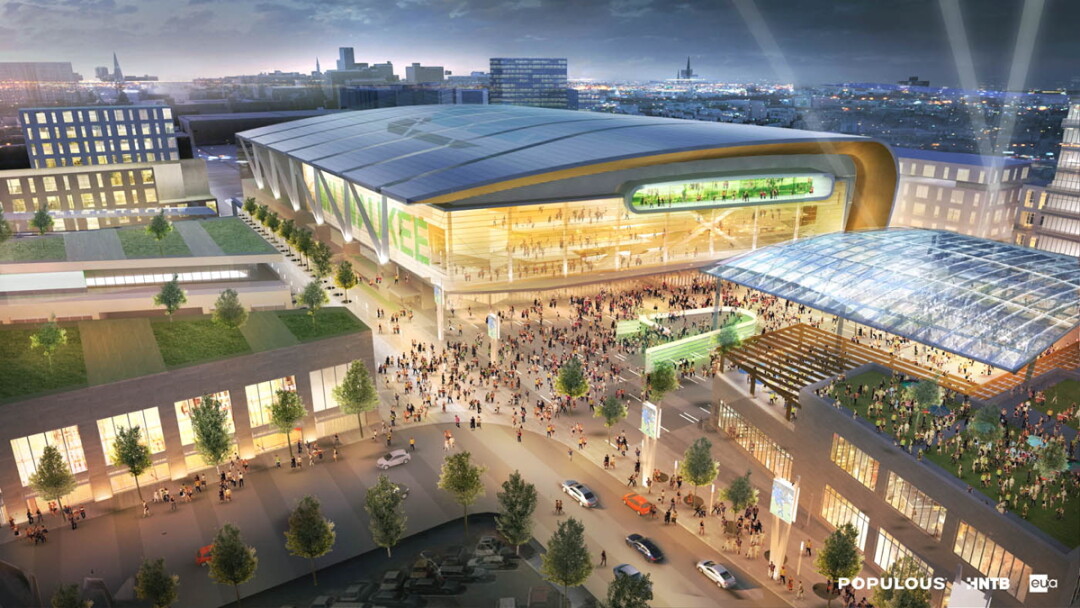Parallel Partnerships
Eau Claire’s Confluence Project, Milwaukee Bucks’ arena have much in common

The cities of Eau Claire and Milwaukee do not have all that much in common. Sure, they are both Wisconsin municipalities with a lot of people who cheer for the same teams and vote for the same elected figures, and many folks in both cities drink a lot of beer. One somewhat unexpected way the cities’ identities recently coincided was in the arcane – and yet controversial – world of TIF districts and public-private partnerships: the Confluence Project and the new Bucks arena.
The proposal to build an updated structure for our state’s NBA team brought a plethora of headlines earlier in the year, many in contrast to budget cuts to the University of Wisconsin System. Yet you may not entirely know how the process ended. Sure, there was the state Legislature’s vote in July, but only in September did the Milwaukee Common Council give the final approval necessary to get the shovels digging and the suites furnished.
We pay our money to build these venues, if only because other cities – in the Bucks’ case, Seattle and Las Vegas – are ready to provide their own.
If you followed the story of the arena proposal, you may have seen echoes of our own local Confluence Project. To wit: a combination of privately raised money and public financing through various means, the use of Tax Increment Financing (a.k.a. TIF) Districts to help with the public part, a belief that building such a fancy facility in a community not known for cultural centerpieces will ignite additional development, and a substantial level of skepticism that the city and region will be changed (other than taxpayer money going to an over-promised/under-delivered white elephant).
When state Rep. Dana Wachs of Eau Claire spoke on his chamber’s floor during the final debate before the arena’s passage, he referenced the Confluence Project. Knowing his support for Eau Claire’s proposal, I recognized how he too saw the positive similarities. The connection was crystallized in my mind as I watched that speech. While I cannot guarantee that these two projects will lead their regional economies to flourish, I backed both on the principle that it is better to have such facilities than to leave them never-constructed.
There was a bit of a viral video that you might have watched this summer. John Oliver’s HBO show Last Week Tonight addressed the topics of rich owners asking for money from the public to build areas that they could pay for themselves. The segment aired right before the state Legislature was set to vote, and there was still a question if enough “yes” votes existed. A few weeks later, a New York Times columnist made a similar case, noting the hedge fund management background of Bucks owners Marc Lasry and Wes Edens. Plenty of Wisconsinites who probably barely knew we had an NBA team – I’m referring to non-basketball fans, not the historic apathy about the team beyond the Milwaukee metro area – were already critical on social media and in person after hearing the governor propose education cuts and state spending on an arena. If there was ever a moment when public opposition could congeal into rejection of the Bucks’ project, this could be it.
I am sympathetic to the concerns. I vehemently opposed the budget cuts – well, much of the budget overall – and know that the Bucks owners could easily afford to build the new place with their own money with more than enough remaining to invest and grow for themselves. I also know that the arena proposal was legislatively separate from the cuts: One of the few differences between the Confluence Project and the arena was the initial rejection of Confluence funding in May, since that money could go to shore up education financing. And I also know that we, whether rightly or wrongly, are playing the professional sports game. We pay our money to build these venues, if only because other cities – in the Bucks’ case, Seattle and Las Vegas – are ready to provide their own. The latter perspective is fatalistic, but, I’m sorry, I want a team in this state. This is part of the literal and figurative cost.
Come 2017 – or, thanks to historical foundational Milwaukee swampiness, maybe 2018 – the arena will be ready; around that time, the Confluence Project will open its doors. Then we shall see how much our cities truly have in common.




















